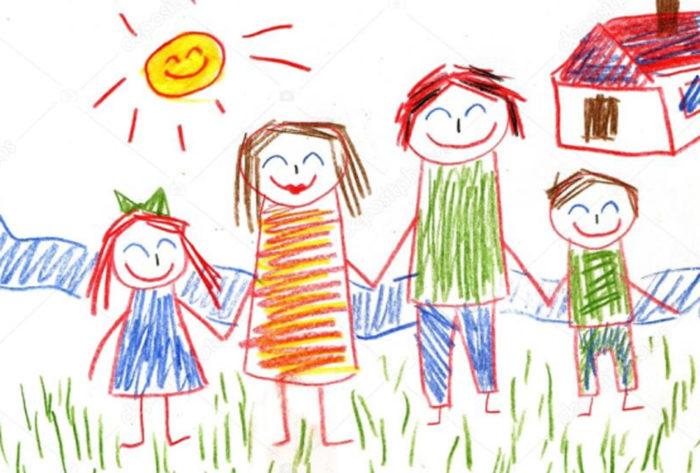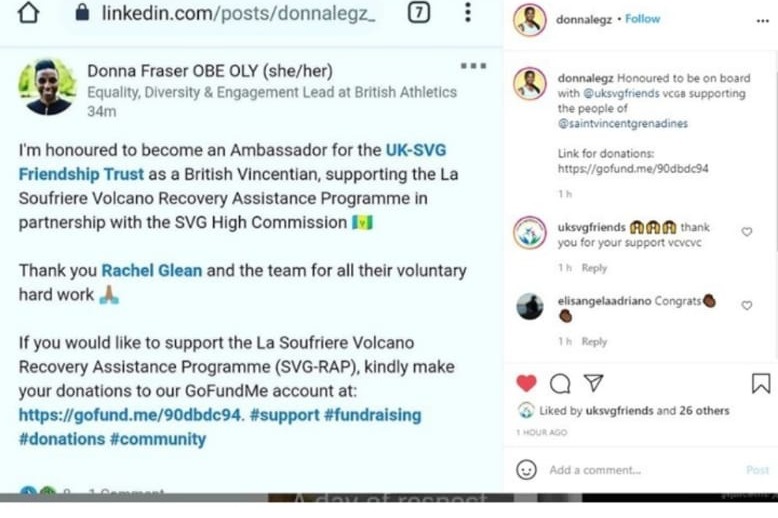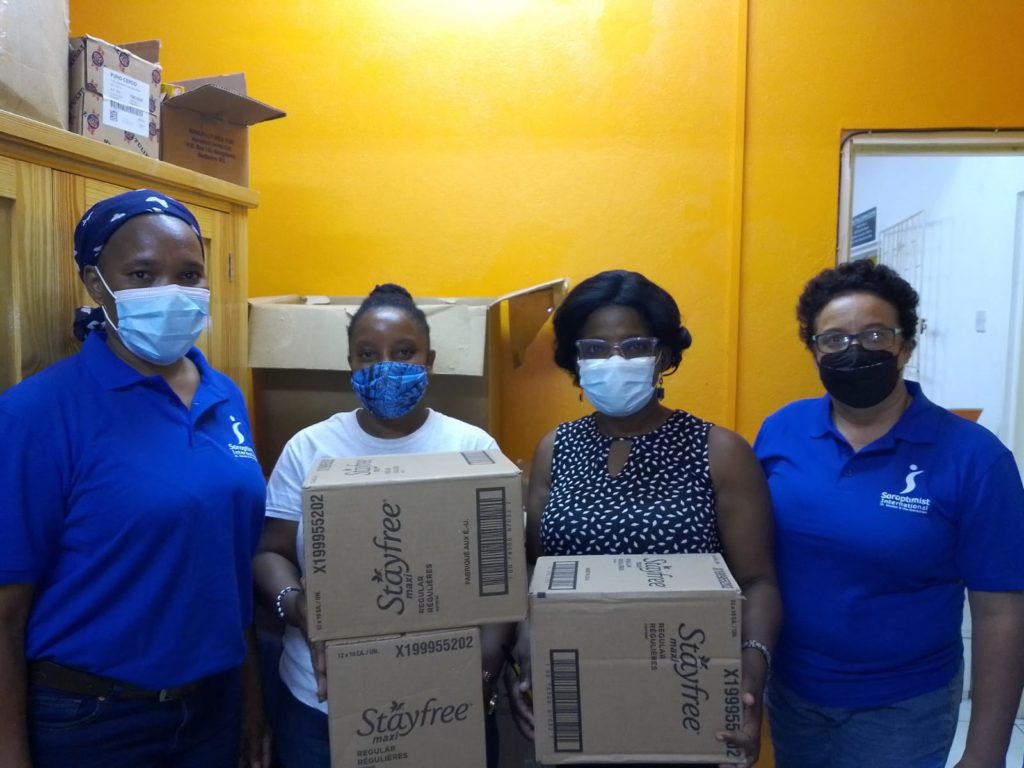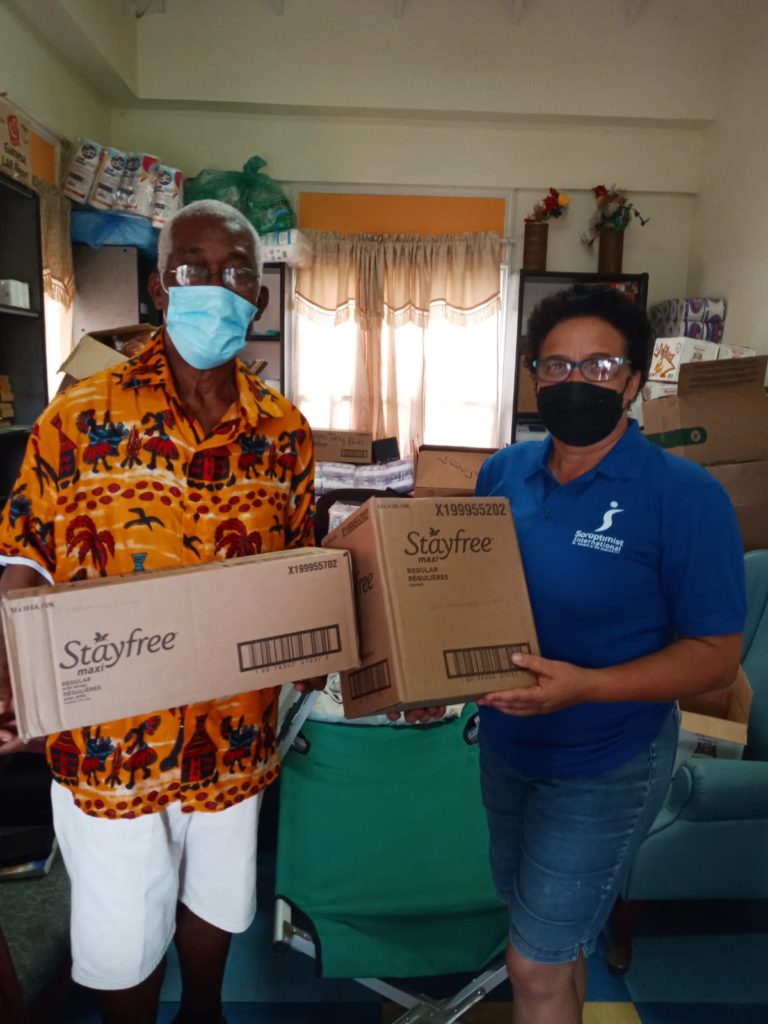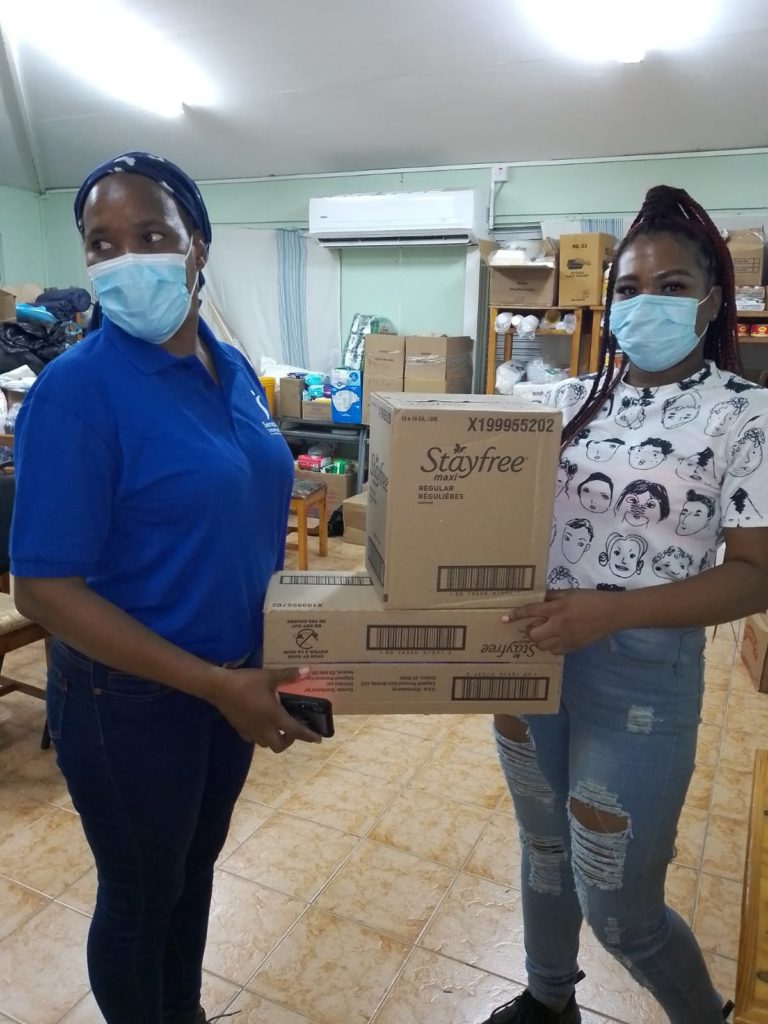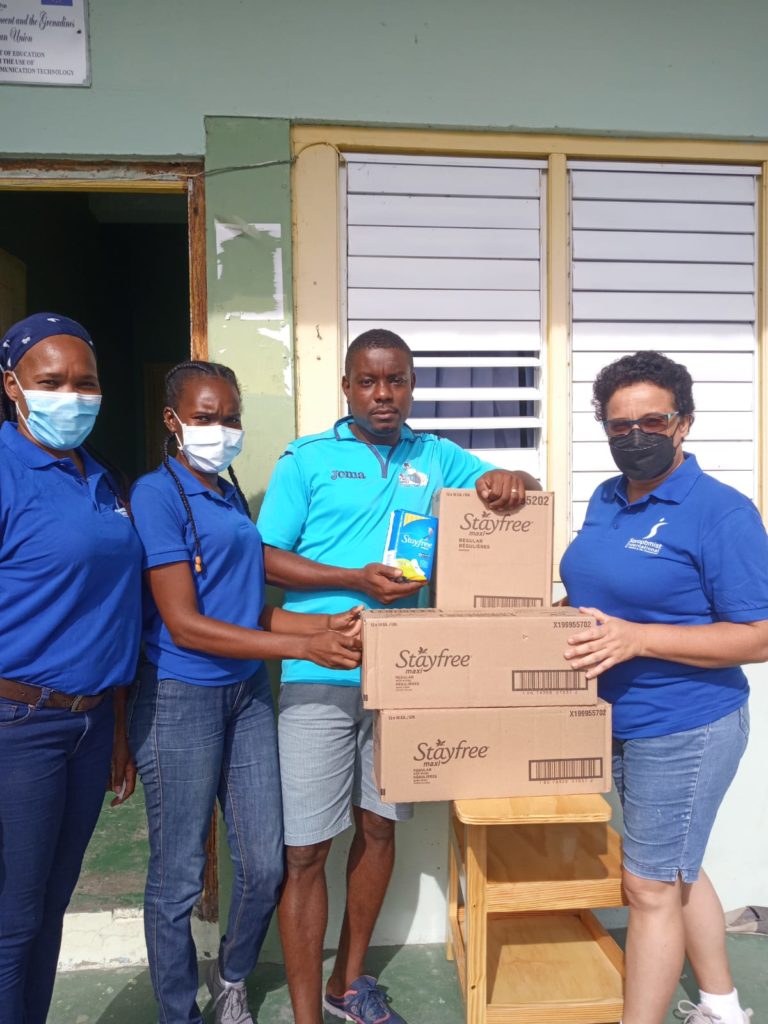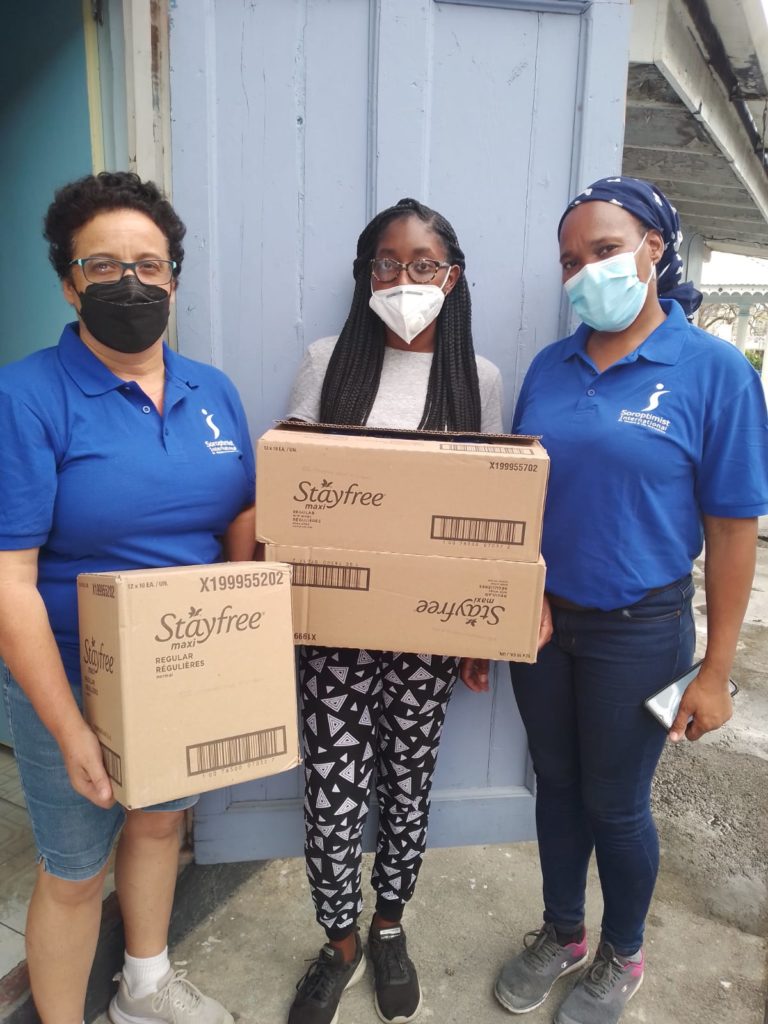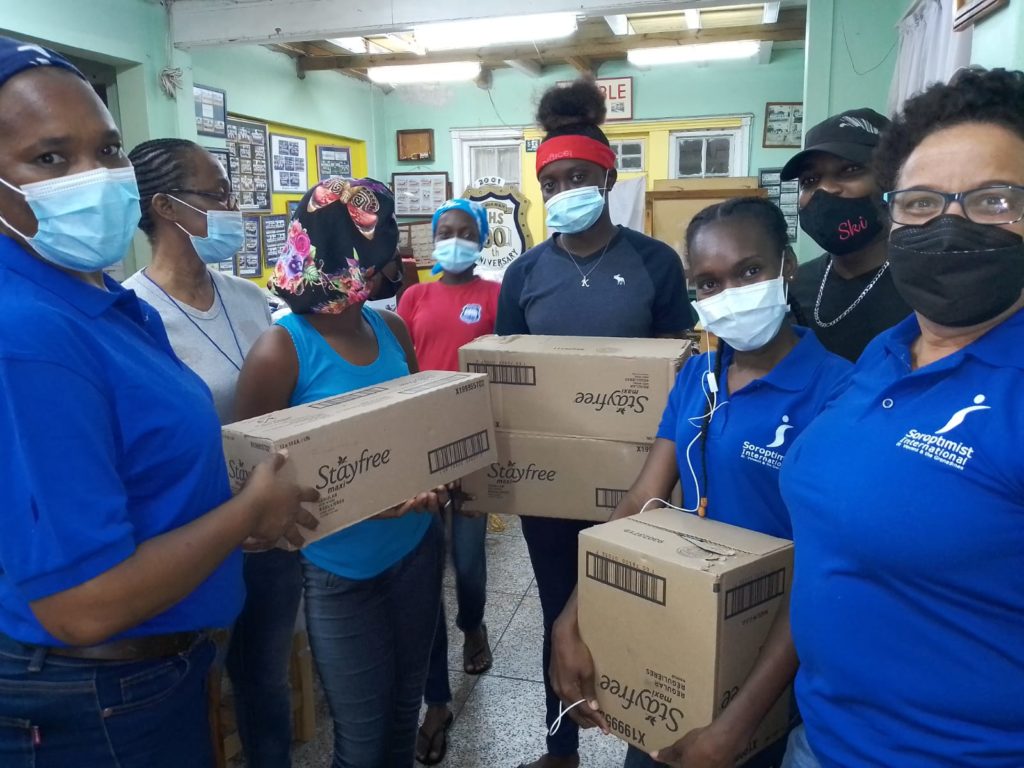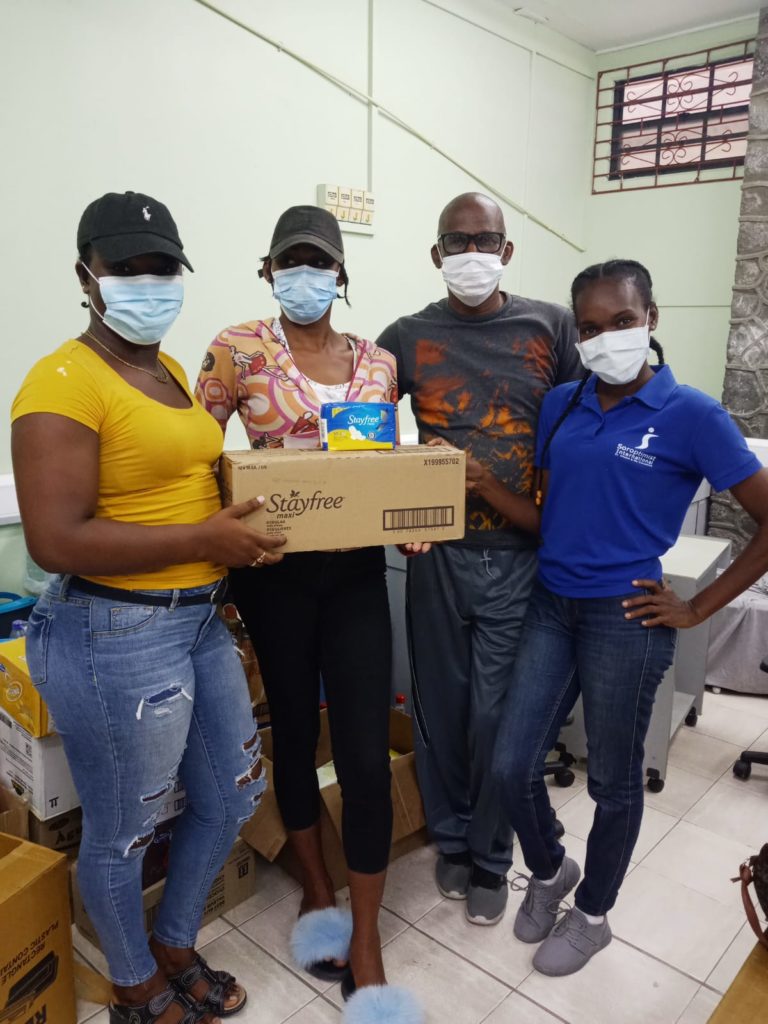5 Considerations When Using Technology for Teacher Professional Development in Low Resource Areas
Repost
The right type of teacher professional development (TPD) is one of the most effective interventions to improve student learning and wellbeing. It’s second only to Teaching at the Right Level (TaRL), though to effectively teach at the right level, TPD is needed. Even before COVID-19 brought about disruptions to schools and in-person teaching, there has been increasing interest in the potential for technology to enhance effective, sustainable, and scalable teacher professional development.

WELCOME DONNA FRASER OBE OLY TO TEAM UK SVG Friends
Four times Olympian for Team GB announced this week on LinkedIn that she is now an official Ambassador for the UK-SVG Friendship Trust.
As a British Vincentian, Donna will continue to use her platform to support our La Soufriere Volcanic Eruption – Recovery Assistance Programme (SVG-RAP) which aims to assist families and friends directly impacted and displaced due to the ongoing eruption.
Our team is ecstatic to work alongside this great champion!
Your donations will help to reach those in need and with Donna’s support, we will ensure that our women, young girls and those living with disabilities are given greater attention.
Remember to share our GoFundMe campaign link and find us on your favourite social media platform by searching for @uksvgfriends.
#StrongerTogether #UKSVGFriends#IdonatedtoSVG#DonatetoSVG
More donations on the ground, 40ft container shipped AND Amazon Wishlist donations. Let’s keep going!
This week we have helped even more people on the ground including a donation of 1,500 Sanitary pad packs to the Ministry of National Mobilisation, Social Development, the Family, Gender Affairs, Youth Housing and Informal Settlement to buffer their various welfare interventions. This is on top of the 3,000 Sanitary packs and 300 food care packages distributed – you can see images in the gallery above.
Continue reading “More donations on the ground, 40ft container shipped AND Amazon Wishlist donations. Let’s keep going!”Diario El País
Taskeen Adam comments on international development projects in the latest article of ‘El País’

“Muchos proyectos se decantan por graduados en Desarrollo Internacional de universidades occidentales, menospreciando la experiencia en el contexto y otros estudios no acreditados bajo ese nombre”
Mother Language Day 2021: Improving data on mother-tongue languages for better learning outcomes
This blog post is a cross-post from EdTech Hub‘s blog https://edtechhub.org/2021/02/20/mother-language-day-2021-improving-data-on-mother-tongue-languages-for-better-learning-outcomes/#ib-toc-anchor-9 (Creative Commons Attribution 4.0). The blog post was written by Briony Gould on the 20th 0f February 2021.
To celebrate International Mother Language Day 2021, EdTech Hub’s Björn Haßler spoke with Alice Castillejo and Mia Marzotto of Translators without Borders. They talked about the importance of mother tongue-based education and the need to support speakers of marginalised languages. This blog post captures their conversation.
“How do we know that speakers of marginalised languages are left behind?”
Alice: Research around the world shows that educational outcomes are worse for students studying in a second language. The use of an unfamiliar language is linked to high dropout rates and low academic achievement.
We also know that 40% of children worldwide are not educated in a language they speak at home. Crucially — if you want to know which learners are left behind,you need to measure it. If you collect language data, you can see which language groups are left behind and adapt your education programming accordingly.
Mia: It’s not only the language of instruction that’s a problem. Many people aren’t reached at all due to other types of language barriers. Children or their parents might not know when to enrol, how to use the school web platform, or how to play the audiobooks. If you can’t use the web, you will have a limited ability to find and access information. Can you imagine school projects without access to at least a book in your own language?
There’s massive information asymmetry if you look at online content by language. On Wikipedia, for example, English is the largest edition in terms of users, followed by German and then French. On the other side of the spectrum, there is an almost complete absence of content in many African and Asian languages.
Source: https://translatorswithoutborders.org/language-data-disparity/
And due to low levels of existing digital content, some widely spoken languages have limited language technology support, including machine translation and search functions. This diagram shows that one can easily find publicly available parallel datasets to develop machine translation tools between English and French. But it is much harder to develop the same tools between English and Hausa, a language spoken by 63 million people globally. So speakers of Hausa and other marginalized languages find themselves on the wrong side of the digital divide – unable to access the information they need, when they need it.
“How do we address this? What are the steps?”
Mia: Let’s first figure out what languages are spoken in the targeted communities. Then we can understand if education materials and services are taken up and used by speakers from all the language groups. As a first step, we need to capture accurate data about which languages are spoken. You can do this by asking, “What are the main languages you speak at home?” in education assessments and other surveys. It might surprise you to learn that there is no freely accessible dataset to find out which languages are spoken where.
Here are some examples of comparative maps.
Alice: So, we need to put aside our assumptions about what languages people speak and understand. For example, Portuguese is only one of many languages spoken in Mozambique. To really understand the diversity of languages, we need to collect, share, and visualise the real picture. Translators Without Borders is trying to help do this through our language data initiative. We can then apply this information: what languages need to be supported in a learning platform? Who drops out early and when? And we can then develop multilingual educational tools for learners and teachers, based on improved data about relevant languages. We can also track educational outcomes by primary language, to ensure no learner is left behind.
“This is very interesting. But which organisations can actually do this, and how much will it cost?”
Alice: Well, that depends on who you are. If you are within the government, you can ask for language to be included in censuses and build language into systematic data collection. You can ask children who register for education, “What is the primary language you speak at home?” and disaggregate data using language going forward.
What does this cost? Well, the time it takes to ask one more question and pull out the additional graphs. It’s hard to quantify, but built within existing systems; it’s a cheap, low-hanging fruit.
Mia: If you work for a humanitarian organisation, you can add 4 simple questions to your routine questionnaires. It costs no more than the assessment would have done anyway and provides a wealth of data for all sectors. And you should take language into account during your data collection. Across the board, we’re learning that language-aware humanitarian action of this kind is an effective and cost-effective way to improve accountability, reach, and impact.
| To fill the gap in humanitarian data on language, add 4 simple questions to needs assessments: 1. What is the main language you speak at home? 2. Which language do you prefer to receive written information in? 3. Which language do you prefer to receive verbal information in?4. How do you prefer to receive information (in-person, radio, TV, poster, leaflet, phone call, SMS, etc.)? |
The added effort around the extra analysis is a few hours of someone’s time. Yet, this can go a long way in filling a critical data gap for more effective programming.
“Okay, once we’ve collected the data, how can we turn it into action?”
Alice: We can use language data to take action on three levels: children, teachers, and systems. Let’s start with children. Using language data, you will be able to tell which language groups didn’t register for school, dropped out early, or consistently underperform. You can then adjust your communication and programming to meet their needs, leaving no one behind.
Mia: We can also take action to support teachers. Recent research in Bangladesh and Nigeria shows that teachers often don’t speak the language of instruction well. When teachers aren’t confident in the language of instruction, they can’t get access to guidance to help them teach. And of course, such materials include critical guidance on child-friendly classrooms or Covid-19 school reopening plans.
Teacher training workshops can be challenging because they use technical language that’s hard to understand. This means teachers can face challenges with teaching and have no available resources to help them overcome these challenges.
| Translators Without Borders’s ongoing research in collaboration with the Global Education Cluster and Save the Children shows teachers ask for materials: By email and print In searchable formats Shorter and in plain language In pictorial and audio-visual formats |
Alice: With language data, we can also take action on a system level. If over 40% of children are educated in a language they don’t speak at home, we need to know how this affects their education. Much as we did for gender, unless we collect data on language inequality, we cannot begin to address this. Collective gathering and sharing of language data can allow us to understand how to increase learning outcomes for speakers of marginalised languages.
“Beyond education, fairer access, and closing digital divides, what else can we do? Give us an idea.”
Alice: Many of us who speak major languages (like English) find it easier and easier to navigate the world. We have readily available machine translation apps conveniently located on our phones or laptops when we need them. This enables us to find and triangulate information, and carry out research. No-one invests in marginalised languages, and here is a demonstration of the difference. Take this source sentence and see what happens when you use machine translation, and what that does for life-saving information for millions of people.
| Source sentence | |
| Your life jacket is under your seat. Place it over your head and tie the straps around you. Inflate your life jacket after leaving the aircraft. | |
| Language and population | Machine translation |
| Hausa, 44 million | Air pollution is under your control. Put it on top of your head and tie it to your body. You can only ventilate the air when you leave the boat. |
| Burmese, 32 million | Your life jackets are under your seat. This is putting your head to form on your own. Cotton. After leaving the plane on your life jackets in the air breathed. |
| Turkish, 75.7 million | Your life jacket is under your seat. Pass it over your head and tie it around the body. Only swallow the life vest after leaving the plane. |
Mia: We urgently need to invest more in language technology solutions for marginalised languages. Natural-language-processing applications such as chatbots can support multilingual, interactive education for those learning remotely. Machine translation and automatic speech recognition in local languages is a service that can be deployed rapidly in crisis situations. It enables people to access the information they need — both online and offline.
Thank you, Alice and Mia, for these insights. You can get in touch with Alice Castillejo if you have a use case for innovative language technology or other language support needs and you would like to collaborate with Translators Without Borders. You can also get in touch with EdTech Hub if you have any further questions or ideas.
Resumo deste artigo do blog en portugués
De forma a se comemorar o Dia Internacional da Língua Materna neste ano de 2021, Björn conduziu uma conversou com Alice Castillejo e Mia Marzotto na Translators without Borders. Falamos sobre a importância da educação na língua materna e a necessidade de apoiar os falantes nativos de línguas marginalizadas.
Segundo pesquisas feitas ao redor do mundo indicam que os resultados acadêmicos são nefastos para alunos que estudam em um segundo idioma. O uso de uma língua desconhecida está associado a altas taxas de evasão e baixo desempenho acadêmico. É sabido igualmente que 40% das crianças no mundo não são educadas na língua que falam em casa ou seja maternal.
Precisamos deixar de lado nossas hipóteses sobre as línguas que as pessoas interagem e compreendem. Por exemplo, a língua portuguesa é apenas uma das muitas línguas faladas em Moçambique. Para realmente compreender a riqueza das diferentes linguagens, precisamos coletar, compartilhar e visualizar a imagem real. Feito isso, podemos aplicar essas informações. Será que é tendencioso que as crianças falem uma determinada língua e de seguida esquecê-la? Desta modo, seria possível desenvolver ferramentas educacionais poliglota para alunos e professores com base em dados aprimorados em idiomas relevantes. A outra hipótese seria de acompahar os resultados curriculares dos alunos na sua língua maternal de forma a garantir a inclusão de todos e o avanço de todos os alunos.
Podemos usar dados de linguagem para actuar em três níveis: crianças, professores e sistemas. Com as crianças, podemos identificar grupos linguísticos que não se matricularam na escola, que desistiram prematuramente ou que tiveram um desempenho consistentemente baixo. Podemos então ajustar nossa comunicação e programação para atender às necessidades deles, sem deixar ninguém para trás. Também podemos tomar medidas para apoiar os professores.
Com os dados linguísticos, também podemos actuar no nível do sistema. Se mais de 40% das crianças estão sendo educadas em um idioma que não falam em casa, precisamos saber como isso afecta sua educação. Assim como fizemos com o gênero, se não coletarmos os dados sobre as desigualdades, não podemos começar a consertar. Coletar e compartilhar dados sobre línguas coletivamente pode nos ajudar a entender como melhorar os resultados de aprendizagem de falantes e nativos de línguas marginalizadas. Precisamos de lhes dar o apoio de que necessitam e merecem.
ملخص هذه المدونة
للاحتفال باليوم العالمي للغة الأم 2021، تحدث بيورن مع أليس كاستيليجو وميا مارزوتو في مترجمون بلا حدود. تحدثنا عن أهمية التعليم القائم على اللغة الأم والحاجة إلى دعم المتحدثين باللغات المهمشة.
تظهر الأبحاث حول العالم أن النتائج التعليمية أسوأ للطلاب الذين يدرسون بلغة ثانية. يرتبط استخدام لغة غير مألوفة بارتفاع معدلات التسرب وانخفاض التحصيل الدراسي. نعلم أيضًا أن 40٪ من الأطفال في جميع أنحاء العالم لا يتلقون تعليمًا بلغة يتحدثونها في المنزل.
نحن بحاجة إلى وضع الافتراضات الخاصة بنا جانبًا حول ما هي اللغات التي يتحدث بها الناس ويفهمونها. على سبيل المثال، البرتغالية هي لغة واحدة فقط من بين العديد من اللغات المستخدمة في موزمبيق. لفهم ثراء اللغات المختلفة حقًا، نحتاج إلى جمع الصورة الحقيقية ومشاركتها وتصورها. بعد القيام بذلك ، يمكننا بعد ذلك تطبيق هذه المعلومات. هل الأطفال الذين يتحدثون لغة معينة يتركون الدراسة في وقت مبكر؟ يمكننا بعد ذلك تطوير أدوات تعليمية متعددة اللغات للمتعلمين والمعلمين بناءً على بيانات محسنة حول اللغات ذات الصلة. يمكننا أيضًا تتبع النتائج التعليمية من خلال اللغة الأساسية ، لضمان عدم ترك أي متعلم دون تعليم.
يمكننا استخدام بيانات اللغة لاتخاذ إجراءات على ثلاثة مستويات: الأطفال والمعلمين والأنظمة.بالنسبة للأطفال ، يمكننا تحديد المجموعات اللغوية التي لم تسجل في المدرسة ، أو التي لم تستمر في دراستها ، أو التي كان أداؤها ضعيفًا باستمرار.يمكننا بعد ذلك تعديل برامجنا لتلبية احتياجاتهم ، دون ترك أي شخص دون تعليم.يمكننا أيضًا اتخاذ إجراءات لدعم المعلمين.أحيانا لا يتحدث المعلمون لغة التدريس جيدًا.
باستخدام بيانات اللغة ، يمكننا أيضًا اتخاذ إجراءات على مستوى الأنظمة. إذا تم تعليم أكثر من 40٪ من الأطفال بلغة لا يتحدثونها في المنزل ، فنحن بحاجة إلى معرفة كيف يؤثر ذلك على تعليمهم. مثلما فعلنا مع الجنس ، إذا لم نجمع البيانات حول عدم المساواة ، فلا يمكننا البدء في معالجتها. يمكن أن يتيح لنا العمل الجماعي وتبادل بيانات اللغة فهم كيفية زيادة نتائج تعلم المتحدثين باللغات المهمشة.
Résumé de cet article de blog en français
Pour célébrer la Journée internationale de la langue maternelle 2021, Björn s’est entretenu avec Alice Castillejo et Mia Marzotto à Translators without Borders. Nous avons parlé de l’importance de l’éducation fondée sur la langue maternelle et de la nécessité de soutenir ceux qui défendent les langues minoritaires.
Des recherches menées dans le monde entier montrent que les résultats scolaires sont, tristement,moins favorables pour les étudiants qui étudient dans une deuxième langue. L’utilisation d’une langue étrangère comme langue d’enseignement principale est fortement liée aux taux d’abandon élevés et à de faibles résultats scolaires. Nous savons également que 40% des enfants dans le monde ne sont pas éduqués dans une langue qu’ils parlent à la maison.
Nous devons mettre de côté nos hypothèses sur les langues que les gens parlent et comprennent. Par exemple, le portugais n’est qu’une des nombreuses langues parlées au Mozambique. Pour vraiment comprendre la richesse des différentes langues, nous devons collecter, partager et visualiser l’image réelle. Cela fait, nous pouvons ensuite appliquer ces informations pour influencer la recherche, la politie et la pratique. Les enfants qui parlent une langue maternelle abandonnent-ils plus tôt? Nous pouvons ensuite développer des outils pédagogiques multilingues pour les apprenants et les enseignants. Cela sera basé sur des données améliorées sur les langues pertinentes. Nous pouvons également suivre les résultats scolaires par langue principale, pour nous assurer qu’aucun apprenant n’est laissé pour compte.
Nous pouvons utiliser les données linguistiques pour agir à trois niveaux: les enfants, les enseignants et les systèmes. Avec les enfants, nous pouvons identifier les groupes linguistiques qui ne sont pas inscrits à l’école, qui ont abandonné prématurément ou qui ont constamment sous-performé. Nous pouvons alors ajuster notre communication et notre programmation pour répondre à leurs besoins, sans laisser personne de côté. Nous pouvons également agir pour soutenir les enseignants. Les enseignants ne maîtrisent pas souvent la langue d’enseignement, qui n’est pas, parfois, leur langue maternelle.
Avec les données linguistiques, nous pouvons également agir au niveau du système. Si plus de 40% des enfants sont éduqués dans une langue qu’ils ne parlent pas à la maison, nous devons savoir comment cela affecte leur éducation. Tout comme nous l’avons fait pour le genre, si nous ne collectons pas les données sur les inégalités, nous ne pouvons pas commencer à y remédier. La collecte et le partage collectifs de données linguistiques peuvent nous permettre de comprendre comment améliorer les résultats d’apprentissage des locuteurs de langues marginalisées.
Resumen de esta entrada de blog en castellano
Para celebrar el “Día Internacional de la Lengua Materna”, Björn habló con Alice Castillejo y Mia Marzotto de ‘Traductores sin Fronteras’. Hablamos sobre la importancia de la educación basada en la lengua materna y la necesidad de apoyar a los hablantes de lenguas marginadas. We talked about the importance of mother tongue-based education and the need to support speakers of marginalised languages.
Investigaciones realizadas alrededor del mundo muestran que los resultados educativos son peores para los estudiantes que estudian en una segunda lengua. El uso de una lengua poco conocida está relacionado con altos índices de deserción escolar y bajo rendimiento académico. También sabemos que el 40% de los niños de todo el mundo no reciben educación en la lengua que hablan en casa.
Necesitamos dejar de lado nuestras suposiciones sobre qué idiomas habla y entiende la gente. Por ejemplo, el portugués es solo uno de los muchos idiomas que se hablan en Mozambique. Para comprender realmente la riqueza de las diferentes lenguas, debemos recopilar, compartir y visualizar la situación real. Una vez hecho esto, podemos aplicar esta información. ¿Los niños que hablan una determinada lengua abandonan pronto la escuela? Con ello podremos desarrollar herramientas educativas multilingües para alumnos y profesores basadas en datos mejorados sobre las lenguas relevantes. También podemos hacer un seguimiento de los resultados educativos por lengua principal, para garantizar que ningún alumno se quede atrás. Podemos utilizar datos de las diferentes lenguas para actuar en tres niveles: niños, profesores y sistemas. Con los niños, podemos identificar cuáles fueron los grupos de lenguas que no se matricularon en la escuela, la abandonaron temprano o tuvieron un bajo rendimiento académico constante. Es así que podemos adaptar nuestra comunicación y diseño de programas educativos para satisfacer sus necesidades, sin dejar a nadie atrás. También podemos tomar medidas para apoyar a los maestros. Con datos de las diferentes lenguas, también podemos actuar a nivel del sistema. Si más del 40% de los niños son educados en una lengua que no hablan en casa, tenemos que saber cómo afecta esto a su educación. Al igual que en el caso del género, si no recopilamos los datos sobre la desigualdad, no podemos empezar a abordarla. La recopilación y el intercambio colectivo de los datos de lenguas habladas, pueden permitirnos comprender cómo mejorar los resultados de aprendizaje de los hablantes de lenguas marginadas.
Summary of this blogpost in Kinyarwanda
Mu kwizihiza umunsi mpuzamahanga w’ ururimi kavukire wa 2021, Björn yaganiriye na Alice Castillejo ndetse na Mia Marzotto bo muri Translators without Borders. Twaganiriye ku kamaro k’ imyigishirize y’ ururimi kavukire ndetse nimpamvu bikenewe gufasha abavuga indimi zahejejwe inyuma.
Ubushakashatsi bwakozwe ahantu hatandukanye kw isi bugaragaza ko umusaruro mu burezi utaba mwiza iyo abanyeshuri bize mu rurimi rw’ amahanga. Ikoreshwa ry’ indimi zitamenyerewe ihuzwa n’ ubwinshi mu mibare ya abareka ishuri ndetse n’umusaruro mucye mu mw’ishuri. Tuzi kandi ko 40% y’abanyeshuri kwisi batiga mu rurimi bavuga mu rugo.
Dukeneye gushyira kuruhande ibitekerezo bidakwiye ku ndimi abantu bavuga kandi banumva. Urugero, Igi Portugal ni rumwe mu ndimi nyinshi zivugwa muri Mozambique. Kugira ngo twumve neza ubukungu bw’ indimi zitandukanye, dukeneye gufata, gusangira ndetse tukareba ishusho nini nyayo. Dukoze ibyo, twakoresha ubu bumenyi. Ese abana bavuga ururimi runaka bareka ishuri kare? Twakubaka ibikoresho mu mashuri by’indimi nyinshi kugira ngo abanyeshuri na abarimu bazamure ubwo bumenyi ku ndimi zifite akamaro. Twakurikirana kandi umusaruro mu myigishirize tugendeye ku rurimi rw’ibanze kugira ngo hatangira umunyeshuri usigara inyuma.
Twakoresha amakuru ku rurimi mu gufata ibyemezo munzego eshatu: abana, abarimu na sisitemu. Mu bana, twamenya amatsinda y’ indimi atariyandikishije mu mashuri, abaretse ishuri kare, n abakomeza kudatsinda. Tumenye ibyo twahindura uburyo uburyo dukoresha na porogaramu kugira duhuze n’ibyo banekeye, nti hagire usigara inyuma. Twanafata ingamba zifasha abarimu. Abarimu nabo kenshi ntago aba bavuga ururimi rw’imigishirize.
Dufite amakuru ku ndimi, twanafata ibyemezo ku rwego rwo hejuru. Niba hejuru ya 40% y’abana biga mu rurimi batavuga mu rugo, tugomba kumenya ingaruka bigira ku burezi. Nkuko twabikoze mu buringanire, Tudukusanyije amakuru ku busumbane, ntago twacyemura iki kibazo. Ikusanya rusange no gusangira amakuru ku rurimi byafasha kumenya uko twakongera umusaruro wu uruvuga mu burezi mu ndimi zahejejwe inyuma.
Reference
Haßler, Björn, Castillejo, A., Marzotto, M., El-Serafy, Y., Khlayaleh, A., Langa, A., Koomar, S., Saadeddin, Z., Tegha, G., & Villavicencio Peralta, X. A. (2021). Mother Language Day 2021. Blog post. DOI: 10.5281/zenodo.4555228 Available at https://docs.edtechhub.org/lib/ZQCX7TX3. Available under Creative Commons Attribution 4.0 International, https://creativecommons.org/licenses/by/4.0/.
El Diario de la Educación
El Diario de la Educación published a nice profile article on Björn Haßler today. Tweet here: https://twitter.com/diarioeduca/status/1356150474836234240.
TVET Research in SUB-SAHARAN AFRICA — New Report
We are pleased to announce that a new report detailing the state of research on Technical and Vocational Education and Training (TVET) in Sub-Saharan Africa is now available in our evidence library. The report was commissioned by the Federal Ministry of Education and Research (BMBF) in collaboration with GOVET (the German Office for International Cooperation in Vocational Education and Training) and is an expanded and revised version of an earlier report, published in 2019 in German.
The report provides an in-depth overview of the research on TVET in Sub-Saharan Africa, with a view to identifying gaps in the research and provide the impetus for further research and the formation of international research networks in TVET in the region. The report is aimed at researchers and practitioners from technical and vocational education and training and related disciplines who are performing research in or about Sub-Saharan Africa (SSA), as well as interested members of the general public.
The 200-page report contains 16 chapters. The report is available as a single PDF; however, each chapter is also available separately (including a chapter bibliography) for ease of access and reuse. The report begins with an executive summary, follows by these chapters:
- Chapter 1 contains the introduction.
- Chapter 2 presents the research design (methodological approach) of the report, including the research questions.
- Chapter 3 offers an overview of the quality and relevance of the publications found on TVET.
- Chapter 4 deals with the conception and practice of TVET.
- Chapter 5 examines the various stakeholders in TVET research and their networks, e.g. the institutions that are involved in TVET and TVET research (e.g. faculties at universities as well as non-university and non-state colleges).
- Chapter 6 deals with topics, perspectives and current debates of TVET research in SSA.
- Chapter 7 carries out a systematic review of the studies on TVET in SSA, i.e., it examines reliable statements made about TVET in relevant research publications.
- Chapter 8 examines models for the design, development, and delivery of TVET
- Chapter 9 looks at gender issues in TVET in SSA, as well as inclusion challenges and strategies.
- Chapter 10 looks at key state actors in TVET (state authorities and key policies) for four countries: Botswana, Ghana, Kenya, and Nigeria. These countries reflect a diverse variety of TVET system structures.
- Chapter 11 examines the importance of non-governmental actors in TVET from a range of countries where information was available, including Ethiopia, Botswana, Ghana, Kenya, Nigeria, Uganda, and Tanzania.
- Chapter 12 looks at national standards, guidelines and quality frameworks in TVET in SSA. The authors examine the role that politics, trade unions and other interest groups play in TVET.
- Chapter 13 focuses on the challenges that arise when implementing guidelines and political decisions.
- Chapter 14 focuses on how institutional framework conditions can be influenced to increase research capacity and performance. It also explores what the research interests and motivations of TVET researchers are in SSA, alongside the current and emerging TVET topics in the region.
- Chapter 15 examines networks for research into TVET. The chapter explores the networks and networking opportunities that are present across and beyond SSA and considers how those could be strengthened.
- Chapter 16 contains a summary and — based on this — some considerations of possible future developments regarding TVET and TVET research.
A number of appendices present additional information, such as an annotated bibliography, the full bibliography for the report, the methodology for the interviews and structured community review, and the results of the structured community review, as well as a list of additional materials for the report.
Access the report here:https://docs.opendeved.net/lib/ZEDIHF57
Access the chapters here: https://docs.opendeved.net/lib/?featured=7B4X227X.KLHQM77T&sort=date_desc
Access the German version of the report here: https://lit.bibb.de/vufind/Record/DS-184013
Launching SharePlusCode: An app for finding your geolocation in remote rural locations
Some years ago, Open Development and Education supported Tanzania Development Trust (TDT) in their mapping campaign to combat female genital mutilation (FGM), a practice affecting more than 50% of girls and yong women in some regions of rural Tanzania. The mapping campaign was launched due to the difficulty of locating girls at risk of FGM as well as the location of safehouses. There are villages of over 10,000 people that don’t appear on maps. OpenDevEd’s work to address this issue sparked the development of a new open-source application: SharePlusCode.
Continue reading “Launching SharePlusCode: An app for finding your geolocation in remote rural locations”AFRICA’S COVID-19 OPPORTUNITY
This blog post is a cross-post from EdTech Hub‘s blog https://edtechhub.org/2020/09/17/africas-covid-19-opportunity/ (Creative Commons Attribution 4.0). The blog post was written on the 17th of September 2020.
Educators in Africa are optimistic about the opportunities that Covid-19 brings for reform and innovation in education.
That’s the headline from a survey eLearning Africa recently conducted, in which 1,600 education and technology professionals from 52 countries in Africa were asked for their thoughts on the longer-term effects of the pandemic.
Continue reading “AFRICA’S COVID-19 OPPORTUNITY”
